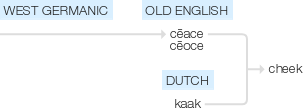Cheek
Old English cē(a)ce, cēoce ‘cheek, jaw’, of West Germanic origin; related to Dutch kaak .
wiktionary
From Middle English cheeke, cheke, cheoke, choke, from Old English ċēce, ċēace, ċēoce(“cheek; jaw”), from Proto-Germanic *kekǭ, *kēkǭ, *kakǭ, *kaukǭ, *keukǭ(“jaw; palate; pharynx”), from Proto-Indo-European *ǵyewh₁-(“to chew”).
Cognate with Saterland Frisian Sooke(“cheek”), West Frisian tsjeak(“jaw”), Dutch kaak(“jaw; cheek”), Swedish käke(“jaw; jowl”), Norwegian kjake(“jaw”), Old Norse kók(“mouth; gullet”).
etymonline
cheek (n.)
"either of the two fleshy sides of the face below the eyes," Old English ceace, cece "jaw, jawbone," in late Old English also "the fleshy wall of the mouth," of uncertain origin, from Proto-Germanic *kaukon (source also of Middle Low German kake "jaw, jawbone," Middle Dutch kake "jaw," Dutch kaak), not found outside West Germanic, probably a substratum word.
Words for "cheek," "jaw," and "chin" tend to run together in IE languages (compare PIE *genw-, source of Greek genus "jaw, cheek," geneion "chin," and English chin); Aristotle considered the chin as the front of the "jaws" and the cheeks as the back of them. The other Old English word for "cheek" was ceafl (see jowl (n.1)).
A thousand men he [Samson] slow eek with his hond, And had no wepen but an asses cheek. [Chaucer, "Monk's Tale"]
In reference to the buttocks from c. 1600. Sense of "brazen insolence" is from 1840, perhaps from a notion akin to that which led to jaw "insolent speech," mouth off, etc. To turn the other cheek is an allusion to Matthew v.39 and Luke vi.29. Cheek-by-jowl "with cheeks close together," hence "in intimate contact" is from 1570s; earlier in same sense was cheek-by-cheek (early 14c.). In ballroom dancing, cheek-to-cheek is from 1919 (earlier it was a measurement of apples).
